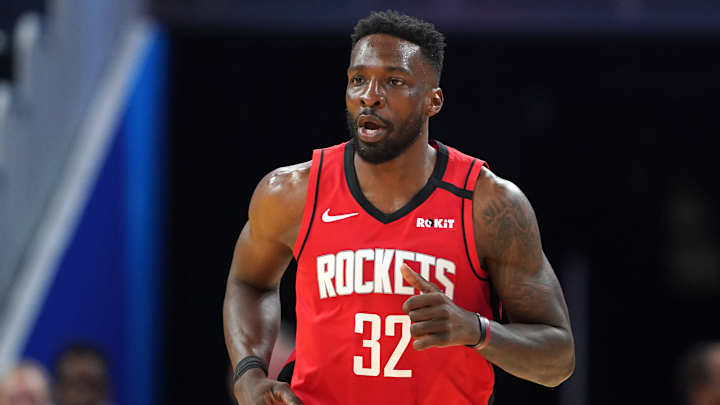Can Jeff Green Be the Rockets' Playoff X-Factor?

With all due respect to Jeff Green, he's never been known as the one of the NBA's most reliable role players. The Georgetown product has been a key player for postseason teams in previous seasons, most recently pouring in 19 crucial points for the Cavaliers in Game 7 of the 2018 Eastern Conference finals. But after nine teams in 12 years–including seven since 2015-16–Green's reputation is fairly entrenched. He remains a talented veteran, albeit one without the most sterling track record.
Perhaps the 2020 playoffs can mark a turning point for the former No. 5 pick. Green has thrived in his abbreviated stint with the Rockets since signing with Houston on Feb. 17, averaging 10.4 points per game on 41.2% from three. Pair his strong play thus far with a clear opening at backup center, and Green is a natural fit to earn significant minutes in the postseason? Why has Green been successful with the Rockets thus far? Let's dive into the tape.
With Clint Capela now in Atlanta and Isaiah Hartenstein relegated to the bench, P.J. Tucker–standing just 6'5"–takes a lions share of Houston's center minutes. And there is limited depth behind the undersized center. Robert Covington is too slight to fill the role, and regardless, he's better utilized covering opponents' top wing or guard. Thabo Sefolosha's offensive limitations keep his minutes in check. Bruno Caboclo is still a year (or two) away from consistent minutes, and DeMarre Carroll has yet to see significant playing time. Green has snagged the backup center role almost by default.
Green is no defensive stopper, and he frankly must always be paired with Covington if Tucker heads to bench. But offensively, it's hard to find a better backup big for Houston's small-ball attack. The Rockets shifted their style to a degree once the calendar turned to 2020, opting for increased usage of five-out lineups (or, more accurately, four-out plus Russell Westbrook). Having Westbrook and one of Capela, Hartenstein or Tyson Chandler on the floor cramped Houston's spacing, clogging up driving lanes for the Rockets' pair of MVPs. Placing Tucker in the corner solves that problem as he stands as a stationary shooter in the corner. Green's placement on the floor is less defined, but his stretch provides similar results.
Green's 41.2% mark from three with the Rockets is due for some regression, yet he remains a competent shooter from beyond the arc. He's shot 34% or better from three four times in his career, and he's evolved into quite the efficient pick-and-pop big man in recent years. Green's ability from three was evident from his first game in Houston.
Green has also proved to be much more than a simple gunner from three. He's fluid and fast diving down the lane in the pick-and-roll, sporting enough athleticism to blow past bigs and finish in traffic. Green isn't shy to attack the tin. He can play with a bit of tunnel vision in the lane, but his finishing prowess is clear.
The ability to make plays in space has served as a true antidote to the Harden trap. Opponents were able to double-team James Harden at will earlier in the season when Capela, Hartenstein or Chandler was on the floor, knowing that none of the aforementioned centers could catch the ball near the foul line and create an open shot.
Capela often froze when he caught the ball, allowing defenses to scramble back into position and eliminate the 4-on-3. Hartenstein has the opposite problem. He is a bit of a bowling ball in the lane, careening off of defenders with little awareness of those around him. Scoring opportunities often became turnovers. Hartenstein is still young, and his talent is certainly intriguing. But a consistent spot in the rotation is more likely to arrive in 2020-21 than the 2020 playoffs.
Green has proved to be a dynamic trap breaker. He's decisive off the catch, though not out of control. He can quickly diagnose the defense and find an open shooter, and if opponents sprint to the perimeter–as they often do against Houston–Green has no problem plowing toward the rim. Green and Harden are outscoring teams by 35.8 points per 100 possessions since Green's debut on Feb. 20, an outrageous mark even in limited minutes. Harden and Green are a downright dynamic in the pick-and-roll, and Green can even make plays in transition. His athleticism is a true asset in the frontcourt.
Perhaps Mike D'Antoni should be careful putting so much stock in Green, though considering his other options, there isn't much of a choice. Green's offensive skillset is tailor made to the small-ball Rockets, and in a pinch, he may unleash a scoring burst at a critical moment. Houston's current roster behind Harden is the result of a series of gambles from Daryl Morey and Co. The addition of Green could be one that truly pays off.
